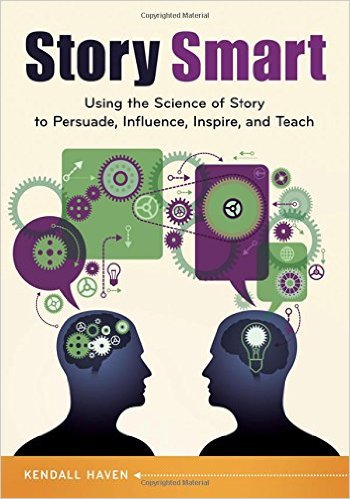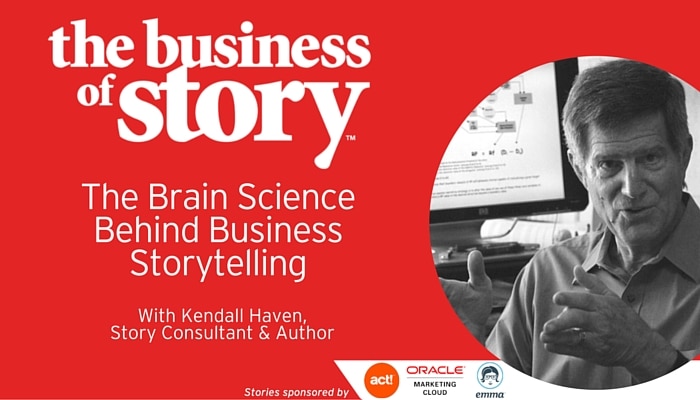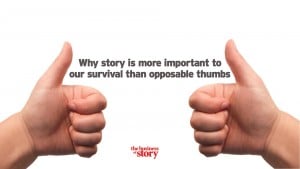Sometimes we get lucky and tell a business story that blows away our audience.
But what if you could share predictably powerful business narratives on a more consistent basis?
You can, but only if you can get passed our primal “neuro-story net” that distorts the messages you’re trying to communicate.
Kendall Haven, who I describe as a Brain Story Surgeon, has authored two books as guides for business story strategists. He shares his organizational story wisdom on this edition of the Business of Story podcast.
We all have a neuro-story net. It is what we sift all incoming information through to make sense of our world. We filter the story we’re hearing at the moment through past experience, knowledge and attitudes, and then self-create a version that makes sense to us.
If we’re the business storyteller, and we don’t use an intentional approach to structuring our stories, chances are the facts that we’re sharing will become utter fiction in the minds of our audiences as they literally make up their own story based on their experiences.
“Understanding story structure lets you vastly reduce the number of people who will misinterpret your information.” – Kendall Haven
Through his studies on the neuroscience of storytelling and the intoxicating effect it has on our brains, Kendall recommends three basic elements to story that allow us to pass through the neuro-story net and have our messages land accurately on the conscious mind. They are…
 Sentence
Sentence
Create a simple, declarative sentence (the theme of your story) that clearly states the one concept you want your audience to connect with.- Image
Craft your sentence/theme so that it creates an image in the minds of your audience - Emotion
Design your sentence and image to illicit an emotion, which will move your audience to action
But before this works, you have to do something Kendall calls “Audience modeling.”
“Figure out who is your audience, their background, issues, and what they know about your subject,” he recommends.
 “Then ask yourself, ‘When they recall that sentence, what picture do I want them to come up with?’ Link a sensory image to those words and the likelihood that your message will be accurately filled into their memory goes way up.”
“Then ask yourself, ‘When they recall that sentence, what picture do I want them to come up with?’ Link a sensory image to those words and the likelihood that your message will be accurately filled into their memory goes way up.”
“The imagery that forms in your mind is more vivid and more detailed when it comes in in story form,” he continued.
This is the genesis point for your story. Who is the character and what kind of character will your target audience most easily identify with and follow? What is your character after and why: their motivation must match the core values and beliefs of your target audience.
Then ask yourself: “Will my character and story promote that one story, one image and one emotional state I want to connect with my audience?”
“You must involve them at an emotional level.” – Kendall Haven
Most of us rely on our intuitive ability or luck to connect with the conscious mind, but it works better if you consciously consider story form, according to Kendall. Once you have your one sentence, one image and one image goal in mind, you can use this intentional story form to bring your story to life
Story Form
- Character positions:
Protagonists, antagonists, climax characters - Goal:
What’s at stake - Motive:
Explains why goal is important - Conflict:
Face obstacles and antagonists that block the character’s progress - Tension:
Risk and the likelihood of failure - Struggle:
We want to watch a character we care about struggle to get past problems and conflict, face risk and danger, to get to a goal that is important to them and relevant to us - Resolution:
Does it end well or poorly?
Craft and tell your story so that your audience sees it in sufficient sensory detail so that they can visualize it and make sense from it.
“Goals and motivations typically get omitted by business. Leave those two out and the vast majority of any audience will assume that any characters and you have far more self-oriented, even sarcastic and narcissistic motives, and therefore look with far more reluctance and suspicion on the story that was intended,” Kendall cautions.
So don’t let your stories get caught up in the Neuro-story net and lose their impact. Follow a pragmatic and intentional approach to story to hack the inner workings of our minds and connect with your audience like never before.
Tune in to hear the rest of the story: Business of Story podcast.
Links from this show:
- KendallHaven.com
- “Story Proof: The Science Behind the Startling Power of Story,” by Kendall Haven
- “Story Smart: Using the Science of Story to Persuade, Influence, Inspire, and Teach,” by Kendall Haven
- “The Storytelling Animal,” by Jonathan Gottschall
- “Houston, We Have a Narrative,” by Randy Olson











